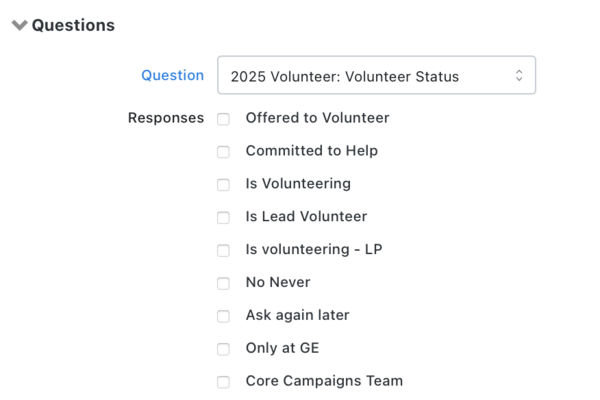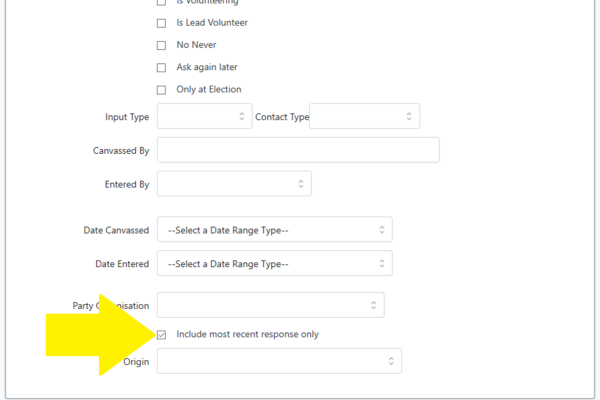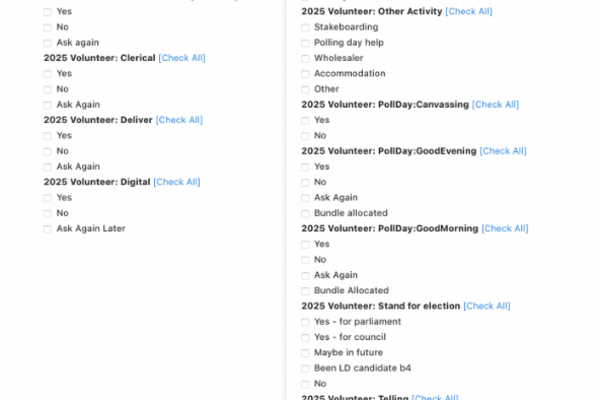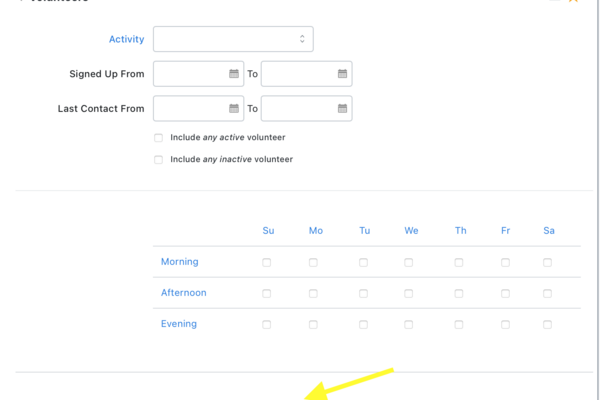Basics of Volunteer Management in Connect
Connect Toolkit
Volunteers are our most valuable resource, and keeping accurate data about them in Connect is the best way to ensure they are being efficiently managed and appropriately communicated with.
Our process enables you to keep track of what stage people are at in their volunteer journey with us, and to keep up to date records of the activities each volunteer will do. This guide will show you how to record information, search through the information we have to find volunteers who need attention, and include tips on how you can use data to help build your delivery networks and activist teams.

The Volunteer Status Question
The Volunteer Status Question shows what stage an individual person is at in their activism.
Answers to this question can come from canvassing via a phone bank or minivan (the question is included in all the standard national scripts), from individuals interacting with forms on our websites (both federal and local Fleet sites) or from entry into connect of paper survey responses.
“Offered to Volunteer” - Has put up their hand in some way (at the doorstep, online, through email, etc.) and said they would volunteer. They have not yet been engaged or asked to take on a volunteer task.
“Committed to Help” - Has committed to help, but has not yet completed the task. An example of this is that the volunteer has committed to write some blue letters, but hasn’t yet written them.
“Is Volunteering” - Means the volunteer is actively engaged in the campaign, and is currently volunteering.
“Is Lead Volunteer” - Means the volunteer is managing or organizing other volunteers. An example of this is a Lead Volunteer who is managing a group of regular canvassers.
“Is volunteering - LP” - Mainly used during GE campaign to show people who were actively volunteering, but only in their local party, and should not be asked to move elsewhere.
“No Never” - Never wants to volunteer and doesn’t want to be asked again.
“Ask again later” - Can’t volunteer right now, but open to being asked again later.
“Only at GE” - Mainly used prior to the GE to show someone who only wants to help when a General Election has been called.
“Core Campaigns Team” - Means the volunteer is part of a core campaign team for a local party and helping in a target seat and does not need any more encouragement to get involved.
The Volunteer Status Question allows you to move people up (and down) the ladder of volunteer engagement as their level of engagement with the campaign may fluctuate over time. It’s crucial that your team regularly updates this question for everyone in your team and regularly runs reports based on the question to check on the status of your volunteers.

When pulling any list that includes the Volunteer Status Question, you must check the “Include most recent response only” box in the questions tab. This will ensure you see their current status rather than an old status.
Where to manage your volunteers:
The Volunteer status question is available in both sides of the database - My Voters and My Campaign, but it is best practice to manage your volunteers in My Campaign.
Anyone who has the volunteer status question answered in My voters (usually from canvassing) will automatically have an entry created for them in My Campaign overnight if they do not already have one.
People who volunteer via our websites will have an entry created for them in My Campaign. In over 80% of cases our systems will be able to match their information with a record in My Voters, but sometimes the information they have given will not be sufficient for a computer match and you will have to investigate further (see linking records section).
Engaging people who have offered to volunteer:
You should regularly run a list in My Campaign of all those people whose last response to the Volunteer status question is “offered to volunteer” and follow up with them to ask how they would like to help. (In some cases these will be people who are already helping, but who have interacted with a website recently.) This will mean that you can follow up people who have offered to volunteer as quickly as possible after their offer - which is the best time to engage them. During election periods it is worth running this list at least weekly to pick up new volunteers.
Keeping in touch with existing volunteers:
It’s also really important to ensure people who are already helping your campaign are personally contacted on a regular basis, both to thank them, and to see if they are willing to do more - turning deliverers into canvassers, and canvassers into councillors, is one of the best ways to grow your team.
You can create a list of anyone who has a committed to help or is volunteering latest response, and then remove everyone who has been contacted (narrowing to doorstep or phone or event to ensure that contact was personal) in the last year. This will leave you with a list of your helpers who you have not spoken to in a while (or at least not recorded a conversation with in Connect) who you should follow up.

As well as recording that people are helping, it’s important to be able to record what they will do. We have a number of questions under the Volunteer: type that allow you to record Yes/No responses to activities.
Only the Volunteer:deliver question is included in the standard canvassing script, as that is the most common positive response people get whilst doing normal canvassing. Most of the questions are included in the activation script, including the Volunteer:other which is used for less common responses, and you can also use the notes function to add details of people that do not fit into the questions.
(If you feel there are other specific questions needed, or other answers to the Volunteer:other, do contact the connect team)
You can use the create a list function to find the people who are best to contact for any specific task - for example, creating a list of everyone who has said yes to Volunteer:canvass and using this to create a phonebank to call people to invite them to an action day. Or making a list of all those who will do clerical work and visiting them with a batch of blue envelopes to address.

Using Connect data to build delivery networks
We all know that a good delivery network is key to winning elections - the more people you can get helping with delivery the fewer leaflets need to be delivered by your core team, freeing them up to do canvassing and other tasks.
If you record all of your existing deliverers in Walk Manager, you can use the Volunteers tab in my campaign to create a list of everyone already attached to a walk sheet, either as a deliverer or wholesaler. One way to effectively use this information and the answers to Volunteer questions is to run a list of everyone who has said yes to the Volunteer:deliver question this cycle (remembering to limit to last response) and then run a list to remove everyone who is already on a walk sheet. This will give you a group of people who have said they will deliver, but have not been assigned a walk, and these people should be swiftly followed up. You can then either add them to a walk or answer the Volunteer:deliver question with “no” or “ask again”, both of which will remove them from this list.
(Some areas have people who will deliver but not regularly - to avoid them being on the list you can tag them using the “helps:backupdeliverer” tag and add an extra step to remove everyone with this tag)
Targets for prospective volunteers who have not yet offered to help.
Once you have followed up everyone who has offered to volunteer for your campaign, you should cast your net wider - contacting those people who may be interested in helping us if asked. This should include your members, registered supporters, petition signers, people who always vote LibDem, and those who get our emails.
Whilst you could create lists of all these people yourself in Connect, we’ve made it slightly easier for you by creating some Volunteer recruitment pools. You can see the details of who is in these pools here
You should create lists for recruitment activity (include the existing members tier if you are recruiting for activists rather than members) going down the tiers until you have a list of the approximate right size in your area.